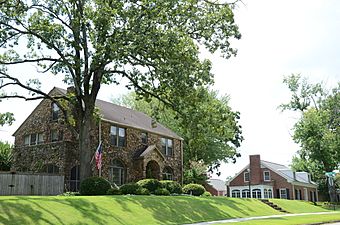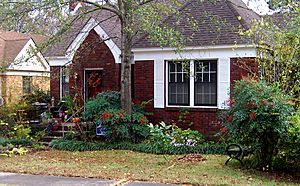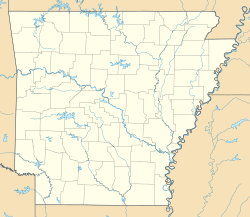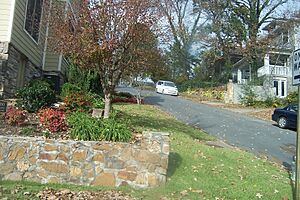Hillcrest (Little Rock) facts for kids
|
Hillcrest Historic District
|
|
 |
|
| Location | Bounded by Woodrow, Jackson and Markham Streets and North Lookout Road. (original); Roughly bounded by Evergreen, Harrison, Lee and Jackson Sts. (increase), Little Rock, Arkansas |
|---|---|
| Area | 665 acres (269 ha) (original); 42 acres (17 ha) (size of increase) |
| Architect | Charles L. Thompson, K.E.N. Cole (original) |
| Architectural style | Classical Revival, Bungalow/Craftsman, Tudor Revival (original) Late 19th And 20th Century Revivals, Bungalow/Craftsman, Late Victorian (increase) |
| NRHP reference No. | 90001920 (original) 92001356 (increase) |
Quick facts for kids Significant dates |
|
| Added to NRHP | December 18, 1990 |
| Boundary increase | October 8, 1992 |

The Hillcrest Historic District is a special old neighborhood in Little Rock, Arkansas. It was added to the National Register of Historic Places on December 18, 1990. People who live here often just call it Hillcrest.
This area is sometimes called the "Heart of Little Rock." This is because it's almost right in the middle of the city. It was also the first neighborhood in Little Rock to have a streetcar. This made it easy for people to travel to and from downtown.
Contents
A Look Back at Hillcrest's History
The Hillcrest Historic District includes several smaller neighborhoods. These areas were planned out between 1890 and 1920. Some of these include Pulaski Heights, Midland Hills, and Elmhurst. This whole area used to be part of a town called Pulaski Heights.
How Hillcrest Became a Neighborhood
In the 1800s, this hilly land outside Little Rock was known as The Highlands. It was a few miles west of the city. In 1888, a company that ran electric streetcars bought a lot of this land. They wanted to build streetcar lines to the area. This would encourage people to move there and use their streetcars.
At first, it was hard to get to The Highlands. There was a deep ditch where train tracks ran. A steel bridge was planned, but it was delayed. This was because of a money problem in 1893. Steel was very expensive back then.
Later, some real estate developers from Michigan bought the streetcar company. They built homes for themselves. A wooden bridge was finally built over the ditch. In 1902, the streetcar line reached the area.
The Streetcar's Route
The streetcar traveled from downtown Little Rock. It went to a stop called Stifft's Station. Then it followed Kavanaugh Boulevard, which was called Prospect Avenue back then. There were several stops along the way. With easier travel, more wealthy people started building homes. The area grew with many different styles of houses.
Most of the homes in Hillcrest today were built in the early 1900s. Many are in the Arts & Crafts or Bungalow styles. Only a few houses from the 1800s are still standing. These belonged to the first investors from Michigan.
Important Buildings in Hillcrest
The Hillcrest Historic District has many important buildings. It includes the first floor of the old town hall. The second floor was damaged by fire in the 1970s.
One of Arkansas's oldest schools is also here. It's called Mount St. Mary Academy. This is a Catholic school for girls. It has been open for over 100 years.
The district also has Allsopp Park. This is a large city park with hills and ravines. It's a great place for outdoor activities.
The Hillcrest area is known for its active community. In 2006, people in Hillcrest helped elect a new representative to the state's House of Representatives. This shows how involved the community is in local decisions.
Protecting Hillcrest's Unique Style
The Hillcrest Historic District was first listed on the National Register of Historic Places in 1990. Its boundaries were expanded in 1992. This was to include even more historic areas.
This district is special because it has many well-preserved homes. These homes show the different architectural styles that were popular before World War II.
Architectural Styles You Can See
Hillcrest is famous for its wide variety of house styles. These homes were built over many years. They show how suburbs changed over time.
Here are some of the architectural styles you can find in Hillcrest:
- Queen Anne
- Colonial Revival
- Pyramid Cottages
- Prairie
- "Foursquare"
- Craftsman
- Craftsman Bungalow
- "Period Houses" - English Revival
- Modernistic Houses
Most of the homes were built between about 1890 and 1940. Some houses in the district are even listed individually as historic places. These include:
- Retan House, at 2510 Broadway
- Werner Knoop House, at 6 Ozark Point
- Reid House, at 1425 Kavanaugh St.
- Williamson House, at 325 Fairfax St.
- Boone House, at 4014 Lookout.
A famous architect named Theo Sanders designed several houses in this neighborhood.




